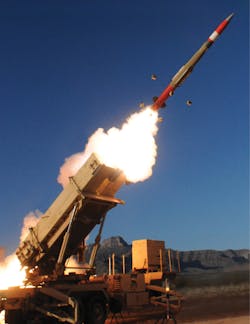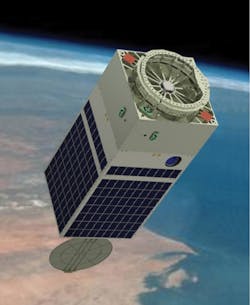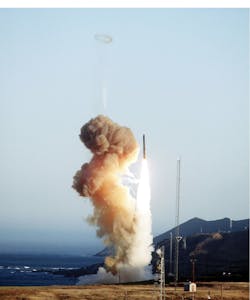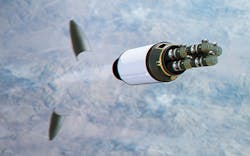Although missile-intercept kill vehicles capture the imagination, electro-optical sensors are the most important component of ballistic missile defense.
By J.R. Wilson
The term "electro-optical sensor" covers a wide range of sensor technologies and applications. At their root, electro-optical (E/O) sensors are electronic detectors that convert light, or a change in light, into an electronic signal, which is analyzed to trigger preset responses.
The capability of any E/O sensor stems from the balancing of two fundamental limits: the combination of resolution and sensitivity, and pixelation. Resolution means how small an object can be usefully seen. Sensitivity means how dim the signal can be before it is overwhelmed by environmental noise. Pixelation refers to sampling of the sensor image.
The Patriot Advanced Capability-3 ballistic missile interceptor is part of the U.S./Allied layered ballistic missile defense system for which electro-optical sensors help provide notification of an enemy missile attack.
The importance of each depends on the state-of-the-art in technology and the mission for which the sensor is employed. Missile launch detection systems involved in ballistic missile defense, for example, look for extremely bright points of light in a cluttered background.
"The ballistic missile threat is growing more sophisticated as countries continue to improve their missiles by increasing the range, incorporating ballistic missile defense (BMD) countermeasures, and making them more complex, survivable, reliable, and accurate," then-MDA Director Vice Adm. J.D. Syring warned the House Armed Services Subcommittee on Strategic Forces in June 2017, one week before his retirement.
Maneuvering threats continue to be developed and fielded. Although hypersonic glide vehicles and missiles flying non-ballistic trajectories were first proposed as far back as World War II, technological advances only now are making these systems practicable. Russia and China announced successful hypersonic glide vehicle launches in 2016.
Missile launch detection systems may be land-, sea-, air-, or space-based, with many missile defense advocates calling for an increase in orbital sensors, which can provide day-and-night, all-weather global surveillance that other kinds of sensors cannot match - especially when the target launch centers are deep within denied airspace, such as North Korea.
The importance of infrared
"The specific tasks for BMD are detection, tracking, and discrimination," says Thomas Karako, a senior fellow in the international security program at the Center for Strategic & International Studies and head of the center's missile defense program. "The first is largely IR [infrared], while tracking the threat crowd as things come apart requires different technologies to sort it all out so the kill vehicle can collide with the most threatening item and avoid the rest. That's the discrimination challenge."
The most important thing, considering today's threats, is to get workable missile-detection sensors deployed without waiting for the next generation in technology, Karako says. "It is important from a policy perspective that we not wait for the best and so thwart the good. Getting space-based sensors is not really a technical problem, but political and cost. There are enough technologies on the shelf right now to allow for a robust space-based missile defense layer without waiting for more advanced technologies to arrive."
A space-based sensor layer is the single most important next step in ballistic missile defense in the 2020s, he adds, to deal with the emergence of a new missile age, not just ballistic, but across all aspects of altitude and range. They provide a better vantage point, more persistence and a different kind of look at the threat cloud created by a missile in mid-course.
IR satellites in low Earth orbit (LEO), viewing the threat cloud from the side, observe not merely the radar cross-section of the warhead and other objects, but also their heat signature contrasted against the cold backdrop of space. Combining terrestrial radars below with electro-optical sensors orbiting above would dramatically help interceptors find their targets.
"It will be a number of years from decision to full fielding, but that's all the more reason to start right now," Karako says. "We currently have a primarily radar-based system and need to add capacity to that to buy time to get additional capabilities into the field to meet a spectrum of threats, not just big ICBMs [intercontinental ballistic missiles].
"We will need a diversity of solutions using a mix of sensors. We are limited by being so heavily reliant on one technology - land-based radar," Karako continues. "We need to move forward to increase diversity and the ability to respond as the threats change, which they will. We will need a diversity of capabilities to deal with the current threat and those that may emerge in the future - not any one silver-bullet system, but a diversity of systems."
A U.S. Navy team simulates the operation of the future MQ-25 during a demonstration of the Unmanned Carrier Aviation Mission Control System (UMCS) at NAS Patuxent River, Md. in April 2017.
Multi-warhead kill
One current effort along those lines is the Missile Defense Agency's Multi-Object Kill Vehicle (MOKV) technology risk reduction program, which will use the latest advancements in E/O technologies to improve the system's reliability while reducing its overall cost, says Bruce Jurcevich, program director-advanced interceptor systems at Lockheed Martin Missiles & Fire Control in Orlando, Fla.
"Advances to E/O sensors have the potential to improve response time for multi-source information fusion, survivability, and reliability in missile defense applications," Jurcevich says.
Lockheed Martin is one of three contractors - along with Raytheon Missile Systems and Boeing Defense, Space & Security - with MDA contracts to define MOKV proof-of-concept prototypes, demonstrate risk mitigation steps, assess the technical maturity of their concepts, and rank enabling technologies to minimize design risks.
"In the past 10 years, E/O sensors have evolved with improved materials, producibility, greater wavelength capabilities, and improved spectral responsiveness at a lower cost," Jurcevich says. "Going forward, I think we'll see a continued focus on lowering the cost of E/O sensors. At the same time, capabilities will advance to include artificial intelligence, machine learning of multisensory data processing, sensor fusion, management of autonomous systems, and wider spectral capacities.
"State-of-the-art IR sensors come in a variety of format sizes and a range of materials and alloys, performing in all spectral bands from short to long wavelength sensors, with extremely low background noise performance," Jurcevich continues. "Ultraviolet sensors come in a variety of advanced substrate materials allowing measurements of ultraviolet radiation using photo diodes, photo cells and multiplier detectors, with spectral response, noise and dark signals optimized for irradiance measurements."
In the Center for Strategic & International Studies "Missile Defense 2020: Next Steps for Defending the Homeland" report, released April 2017, Karako and co-authors Ian Williams and Wes Rumbaugh noted "no missile defense system is better than the sensors and command-and-control systems that determine where the threat is and how to kill it.
"While interceptors tend to capture the imagination, sensors are the underappreciated backbone of missile defense operations," the authors wrote. "Sensors are required across the entire intercept cycle: early warning, tracking, fire control, discrimination, and kill assessment. Homeland missile defense depends on sensor information from a wide array of ground- and sea-based radars as well as overhead satellites."
A U.S. Army Kestrel Eye satellite deploys from the International Space Station. The electro-optical nanosatellite will enable tactical leaders to synchronize action, seize the initiative, and maintain near-real-time situational awareness.
Command and control
Ballistic missile defense sensors feed information about the target to the ground-based midcourse defense (GMD) fire-control component at Schriever Air Force Base in Colorado Springs. Supported by command, control, battle management, and communications (C2BMC) software, the system integrates and transmits this information to ground-based interceptors in-flight via in-flight interceptor communications system (IFICS) data terminals (IDTs).
Space-based components of the U.S. BMD effort include the nearly half-century old Defense Support Program (DSP) constellation of IR satellites in geosynchronous (GEO) orbit, the GEO and high-elliptical orbit Space-Based IR System (SBIRS), launched into high-Earth orbit in 2006 and to GEO in 2011 to replace DSP and the LEO variable wave-band IR Space Tracking and Surveillance System Demonstrator (STSS-D), designed to provide persistent in-depth sensor coverage of missiles from space. STSS-D was launched in 2009, but has not been fully integrated.
A combination of space-, ground-, and sea-based systems using E/O sensors to detect and track a missile launch, was demonstrated in May 2017 against an ICBM-level target launched from Kwajalein Atoll between Hawaii and Guam in the Western Pacific. Initially guided by the combined sensor data, a ground-based interceptor (GBI) was launched from Vandenberg Air Force Base Central California. Once in space, the GBI released an exoatmospheric kill vehicle (EKV).
It was the first full intercept test of the EKV's new capability enhancement-2 block I which used its own onboard electro-optical sensors to locate and crash into the target. It was the first intercept of an ICBM by GBI or any other BMDS component.
"Success of this test will allow MDA to meet the commitment to deliver 44 GBIs by the end of 2017. We plan to conduct the FTG-11 operational intercept flight test in the fourth quarter of FY 2018, which will demonstrate the capability of the GMD system with a two GBI salvo engagement of an ICBM-range target," former MDA Director Syring told lawmakers.
Newer efforts from MDA include the Space-based Kill Assessment (SKA) experimental program to determine the potential for using commercially hosted satellite payloads to place sensors in orbit. Sensors being developed by the Johns Hopkins University Applied Physics Laboratory and placed aboard a network of commercial satellites will assess missile intercept success rates and relay information to the warfighter, improving shot doctrine by ensuring that extra interceptors are not launched at a threat that has already been neutralized.
As many sensors as possible
"The perennial desire with sensors is to have as many as possible, from as many different vantage points as possible, with as many different technologies or phenomenology as possible - and then to effectively integrate their inputs and make sense of them through a centralized command and control network," reads the Center for Strategic & International Studies report. "The importance of sensors cannot be overstated. Improvements in sensors may, at the margin, be one of the best ways to improve lethality, raise effective magazine capacity and contribute to a more robust defense. As one study observed, redundancy of sensors is another form of layering.
"In the absence of operational space-based sensors overhead, the homeland missile defense mission is dependent on only terrestrial radars for tracking and discrimination," the study continues. "This places a larger burden on the sensor network, which makes it harder to identify the objects within the threat cloud of an incoming missile. As such, more of the objects within the cloud would need to be engaged to ensure the warhead is destroyed. This in turn means firing more interceptors at a single threat cloud, reducing the effective capacity of the GBI magazine."
Ballistic missiles have been a major threat, and a major challenge for electro-optical sensors, for more than half a century.
Richard Matlock, MDA's program executive for advanced technology, says the nation's current reliance on SBIRS and the Sea-Based X-Band Radar to detect ballistic missile launches, supplemented by other terrestrial sensors, cannot provide the persistent global sensor coverage needed to deal with an evolving, more maneuverable, and more complex threat. Instead, MDA is calling for a "globally persistent space-based sensor array," including radar and electro-optical sensors, that can detect, track, and target a missile from launch to termination.
"It's so important that we make this broader shift from a terrestrial-based system to a system that primarily plays from space in the next couple of years," Matlock says. The MDA Advanced Technology Program Executive Office is pursuing research avenues to improve electro-optical sensors for BMD. Those include:
Discrimination Technology: The near-term goal is to add high-altitude airborne or space-based electro-optical sensors into the Ballistic Missile Defense System (BMDS) architecture that can acquire, track, and discriminate ballistic missile targets. The Agency is developing and testing those sensors on-board currently deployed unmanned aerial vehicles.
Advanced Concepts and Performance Assessments: A "Smart Buyer" approach, using model-based engineering tools and techniques, assesses emerging missile defense needs and analyzes alternative concepts and technologies to inform requirements, reduce risk and ensure cost-effective mission solutions.
University Research Programs: The Agency awards contracts to colleges and universities to develop next-generation technology for possible implementation into the BMDS. Research is ongoing in many technology areas, including minimizing the impact of debris, rapid response architecture optimization, propulsion, electro-optical sensors, and materials characterization.
Small Business Innovation Research (SBIR) Program: SBIR harnesses the innovative talents of the nation's small technology companies. It funds early-stage R&D designed to stimulate technological innovation, increase private sector commercialization of federal R&D, increase small business participation in federally funded R&D and foster participation by minority and disadvantaged firms in technological innovation.
Small Business Technology Transfer (STTR) Program: Similar in structure to SBIR, but funds cooperative R&D projects involving a small business and a research institution (e.g., university, federally funded R&D center, nonprofit research institution). STTR facilitates moving ideas from the nation's research institutions to market, where they can benefit private sector and military customers.
MDA has asked Congress for $17 million to continue the SKA experiment, using fast-frame IR sensors as part of an integrated post-intercept kill assessment capability. Syring testified SKA payloads began being installed on commercial host satellites in December 2016 and the full network should be on orbit in 2018.
"We are investing in radars and developing advanced electro-optical sensors to achieve a diverse sensor architecture that eventually will provide highly accurate midcourse tracking and discrimination," Syring told Congress.
The Multi-Object Kill Vehicle (MOKV) project seeks to kill several incoming ballistic missile warheads with one missile launch. It will launch as many as six MOKVs on one booster rocket, deploy at the edge of space, steer toward, and destroy several incoming ballistic missile warheads and decoys using separate kinetic hit-to-kill weapons.
Syring told lawmakers tests of the Terminal High Altitude Area Defense (THAAD) system - 15 successful intercepts in 15 attempts - prove it can shoot a ballistic missile out of the sky, but next-generation BMD systems will need to go one step further, using new radar technologies and sensor algorithms that enable weapons systems not only to detect a threat, but also to know what the exact threat is.
Size, weight, and power
Also influencing the future development and use of E/O sensors is size, weight, power consumption, and cost (SWaP-C), with miniaturization and continued development of longer-lasting, smaller, lighter power systems being key.
"At the end of the day, SWaP-C is always a driving factor, no matter what the initial requirements may indicate. Eventually volume, weight, and power will limit what a sensor can do and hence the capability of the overall system. Cost is always in the mind of the designer as it ultimately dictates if a program will succeed from a cost/benefit ratio," says Chris Dobbins, experimental developer for IR & optical technology at the U.S. Army Aviation and Missile Research, Development, and Engineering Center (AMRDEC).
"Infrared sensor technology has moved tremendously in the past 10 years. The detector pixel sizes have reduced to the point where they are no longer the limiting factor in design," Dobbins says. "As pixel sizes have reduced, the array sizes have increased into the megapixel realm. Detector operating temperature has gone up due to new HOT (High Operating Temperature) material advancements."
Electro-optical sensors typically combine light detection technology with software that controls multiple light sources, bombarding a target with different light waveforms at different angles. The reflected light waves then are analyzed to identify characteristics of the detected object. Syring told Congress that MDA has a special focus on designing sensor algorithms that can distinguish lethal threats from non-lethal threats.
In a paper presented at the third International Conference on Control, Automation, and Robotics (ICCAR 2017), two researchers from the Naval Postgraduate School's Systems Engineering Department, Chee Mun Kelvin Wong and Oleg Yakimenko, postulated the use of unmanned aerial vehicles (UAVs) equipped with E/O sensors to detect and track ICBM launches. The paper, "Rocket Launch Detection and Tracking Using E/O Sensors," said their ultimate goal is to assess parameters of ICBM ascent and provide aiming information to bring the attacking UAV onto the intercept course to deploy a hit-to-kill interceptor missile.
E/O sensors also are seeing a new BMD role aboard manned aircraft. In April 2017, Northrop Grumman Mission Systems won a $99.5 million contract by the Naval Air Systems Command (NAVAIR) for the Large Aircraft Infrared Counter-Measures program. LAIRCM will put laser-based E/O missile defense systems aboard a variety of U.S. Navy and Air Force aircraft to automatically detect a missile launch, determine if it is a threat, and activate a high-intensity laser-based countermeasure system to track and defeat the missile.
Aircraft scheduled to receive LAIRCM include the C-5, C-17, C-37, and C-40 cargo and utility jets; C-130H and MC-130W four-engine utility turboprop aircraft; CV-22 tiltrotor aircraft; KC-46 aerial refueling jet; Navy P-8A maritime patrol jet; and some large military helicopters. U.S. Air Force C-17 and C-130 aircraft will receive early stop-gap versions, using an ultraviolet sensor, countermeasure processor, and small laser turret assembly.
The U.S. Missile Defense Agency's Multi-Object Kill Vehicle (MOKV) program, which uses the latest advancements in E/O technologies to improve the system's reliability while reducing its overall cost.
Follow-on infrared systems
Follow-on infrared systems will incorporate a smaller laser turret and provide better resolution and performance in optical clutter, as well as increased range of detection. LAIRCM is seen as a forerunner to the future development of aircraft-protection IR countermeasures able to detect and classify incoming missiles, then emit a custom jamming energy to defeat them.
The threat of a North Korean missile attack on Guam has seen the emergence of a new role for the General Atomics MQ-9 Reaper UAV, the world's first armed UAV.
Now Reapers modified with special Raytheon Multi-Spectral Targeting System C sensors will scan the skies between North Korea and Guam. Using electro-optical infrared sensors to detect the boost phase heat of a missile and data from two or more Reapers, the system can triangulate on the missile's plume to create 3D targeting data for U.S. Navy interceptor warships.
While declining to go into detail, General Atomics President David Alexander says efforts are in progress to improve the Reaper's contribution to missile defense. "Let's just say that within the next few years, there's lots of improvements in the tracking capability. The accuracy in the early part of the boost phase that this provides is game-changing."
The company also has plans to repurpose its Predator C "Avenger," originally designed for the Navy's cancelled Unmanned Carrier-Launched Airborne Surveillance and Strike (UCLASS) combat UAV, as a BMD platform. The Avenger's large 3,000-pound capacity weapons bay is being retrofitted to hold the United Technologies long-range MS-177A multi-spectral sensor system, which currently is being flown on competitor Northrop Grumman's Global Hawk UAV.
"That would be a sensor so big you couldn't really put it on an MQ-9," Alexander explains, adding that General Atomics is looking to the future with another long-range sensor with "very large aperture, if you wanted to fly this airplane along the border of someone else's country and look deep in."
Multi-spectral targeting
One of the most widely deployed E/O sensor systems is the Raytheon Space and Airborne Systems Multi-Spectral Targeting System (MTS), with more than 500 installed aboard U.S. Navy aircraft in the last 15 years.
The system's electro-optical, full-motion video camera system enables long-range surveillance and high-altitude acquisition, tracking, and laser designation. The MTS-C variant includes a long-wave IR detector to track cold bodies, such as missiles and warheads after boost phase, as well as missile and rocket plumes and exhaust during boost.
As with nearly every element of technology, especially where split-second military understanding and decisions are required, the role artificial intelligence may play in at least some of the BMD sensor environment remains to be answered.
"At the birth of infrared sensors, the information was generally pumped directly to a display with minimal processing for a user to decide what to do with it. Now, the sheer magnitude of information and array formats demands up front processing before a user ever sees it," Dobbins says.
"For a missile that is lock-on-after-launch, the target imagery is never seen by human eyes," Dobbins adds. "The missile is not AI, but a state machine. It follows a set of actions based on what it is presented. Put simply, told via algorithms to go here, open your eyes, look for the target and engage the target."






